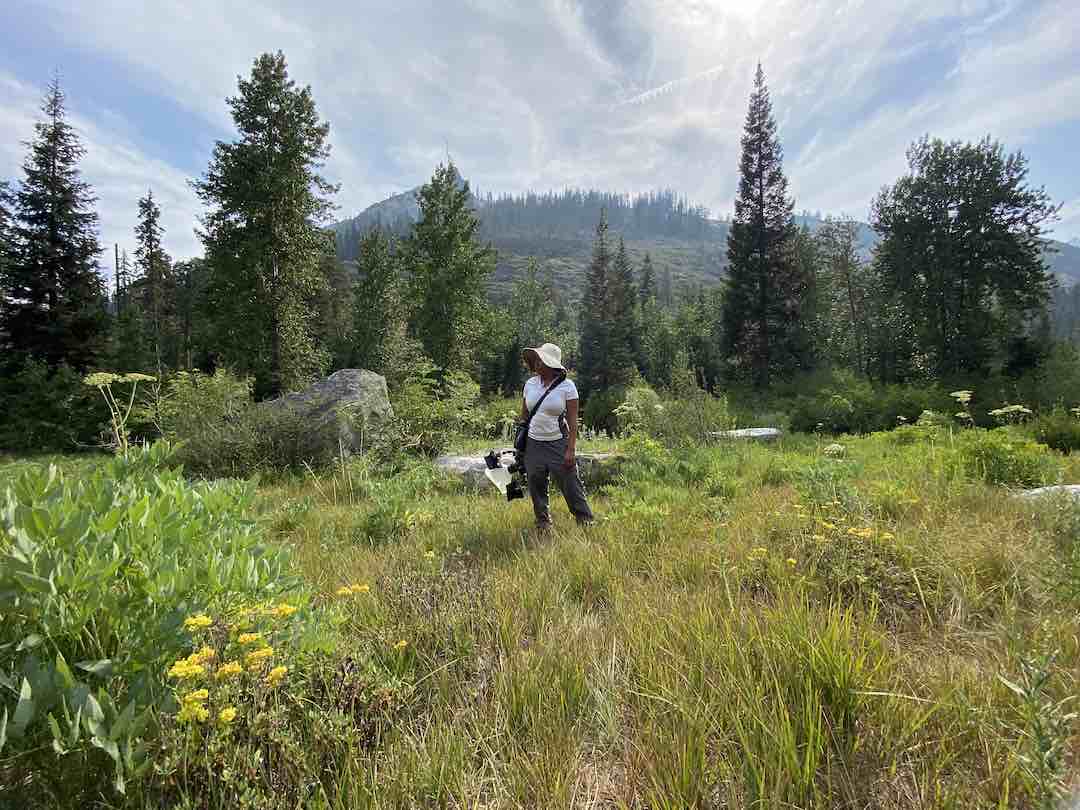Doug Beetle chats with:
Conservation photographer
Krystle Hickman

Krystle in the field with a bee on her finger. Supplied Krystle Hickman
Krystle Hickman is an artist. She is also a community scientist and conservation photographer who loves native bees! Krystle lives in California, USA. She travels around photographing bees wherever she can find them, from cities to wild areas. Krystle loves to teach others about the beauty and importance of native bees!
Read on to meet some awesome little bees!
Doug Beetle: How did you become interested in bees? Were you interested in insects as a kid?
Krystle: Nature and pretty much everything in it has always been very fascinating to me. As a kid I enjoyed catching spiders and ladybugs and keeping them in jars. As I got older I started to appreciate nature as something to observe and appreciate outside of a jar.
It’s hard not to observe nature and not see the bees in it. Bees have been talked about for as long as I could remember as something that needs to be saved. I, like most people, thought save the bees meant save the honey bees. I started out taking pictures of honey bees to try and educate myself and the general public about them and their decline … now, I exclusively photograph native bees and their ecosystems.

Doug Beetle: Most people are familiar with honey bees. Why should people know and care about native bees?
Krystle: Honey bees seem to have a very good marketing team. The general public thinks very highly of them. However, they can destabilize native ecosystems by outcompeting native pollinators for resources. And I would argue they shouldn’t be used in farming. Relying on a single non-native insect in farming isn’t sustainable.
There are a few farms in California that are farming alongside native ecosystems and it reduces the need for pesticides and herbicides and helps create a space for native bees and other pollinators. Land loss is one of the biggest threats to native bees.
What I would like people to know about native bees is how interesting they are. They come in so many different colors like white, green, blue, and so many more.
Some native bees have a special relationship with plants, called a symbiotic relationship, where they only pollinate one specific kind of plant. Some plants are only pollinated by one kind of pollinator. This is a relationship that evolved over potentially millions of years. If one or the other disappears it can be disastrous for this relationship. Think of what happened in Australia after the eucalyptus forests burned in those raging fires. Koalas that survived the fires started starving because they didn’t have enough food to eat.
Also, I think it’s really important to remember that just because a creature doesn’t directly benefit us or look cute and fluffy doesn’t mean it is any less important.

Doug Beetle: It surprises many people how colorful bees can be because we mostly think of bees as yellow and black like honey bees. What are your favorite colors of bees that you have found?
Krystle: I don’t have any favorite colors of bees. However, a lot of people really love Agapostemon. These are beautiful green sweat bees that look like they’re ready for the runway.
Below is a photo of a female Agapostemon melliventris (honey-tailed striped sweat bee) that I photographed in the Mojave Desert. She’s gorgeous!

Doug Beetle: Many people think that bees are scary because of their stings. Are you ever scared of bees? Do you have any advice for kids who are scared of bees?
Krystle: I think the best way to be less scared of bees is to spend more time with them. Once you get to know something it’s harder to be scared of them. At the very least you’ll appreciate them more. Also, native bees rarely sting. I’ve handled them for years, barehanded, and I have never been stung.
Doug Beetle: What advice do you have for young people who want to learn more about native bees?
Krystle: I would tell young people that nature doesn’t have to be a place you travel to. It can be in your own backyard. If you want to learn about native bees or anything in nature create a native habitat in your yard by planting a few plants. Spend time in your yard and see what shows up.
Doug Beetle: What is the cutest bee that you have found?
Krystle: I love finding sleeping bees. They’re so cute!
You can usually tell a bee is sleeping because of lack of movement. Quite a few males will sleep with their mandibles clamped onto stems or in flowers. If you find them like that they’re sleeping or in diapause.
These are sleeping Diadasia bituberculata (bindweed turret bees). The first female is sleeping in grass. The other is sleeping feet up, legs covered with pollen in a burrow she made.

Keep a lookout for native bees!
Are there any native bees that live in your local area? Find out and go on an adventure to see if you can spot one! You can look in your garden, local park, or a nearby reserve. Take your family, friends, or classmates on the adventure with you. Native bees are important pollinators that help keep our ecosystems healthy.
Remember: BEE kind to native bees!








